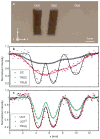Time-reversed ultrasonically encoded optical focusing into scattering media
- PMID: 21532925
- PMCID: PMC3083021
- DOI: 10.1038/nphoton.2010.306
Time-reversed ultrasonically encoded optical focusing into scattering media
Abstract
Light focusing plays a central role in biomedical imaging, manipulation, and therapy. In scattering media, direct light focusing becomes infeasible beyond one transport mean free path. All previous methods1-3 to overcome this diffusion limit lack a practical internal "guide star."4 Here we proposed and experimentally validated a novel concept, called Time-Reversed Ultrasonically Encoded (TRUE) optical focusing, to deliver light into any dynamically defined location inside a scattering medium. First, diffused coherent light is encoded by a focused ultrasonic wave to provide a virtual internal "guide star"; then, only the encoded light is time-reversed and transmitted back to the ultrasonic focus. The TRUE optical focus-defined by the ultrasonic wave-is unaffected by multiple scattering of light. Such focusing is especially desirable in biological tissue where ultrasonic scattering is ~1000 times weaker than optical scattering. Various fields including biomedical and colloidal optics can benefit from TRUE optical focusing.
Conflict of interest statement
Figures



References
-
- Vellekoop IM, Mosk AP. Focusing coherent light through opaque strongly scattering media. Opt Lett. 2007;32:2309–2311. - PubMed
-
- Vellekoop IM, van Putten EG, Lagendijk A, Mosk AP. Demixing light paths inside disordered metamaterials. Opt Exp. 2008;16:67–80. - PubMed
-
- Primmerman CA, Murphy DV, Page DA, Zollars BG, Barclay HT. Compensation of Atmospheric Optical Distortion Using a Synthetic Beacon. Nature. 1991;353:141–143.
-
- Popoff SM, et al. Measuring the Transmission Matrix in Optics: An Approach to the Study and Control of Light Propagation in Disordered Media. Phys Rev Lett. 2010;104:100601–100604. - PubMed
Grants and funding
LinkOut - more resources
Full Text Sources
Other Literature Sources
